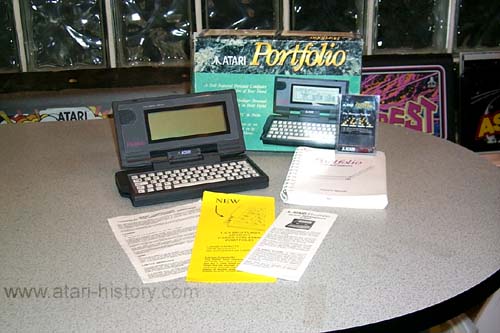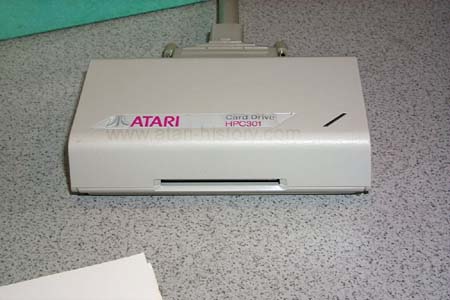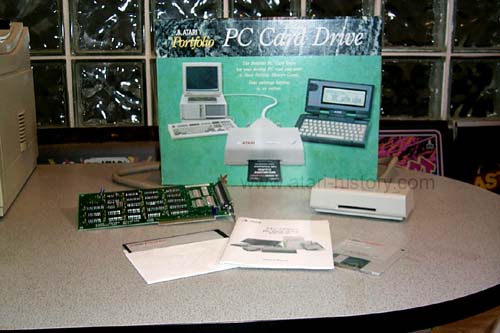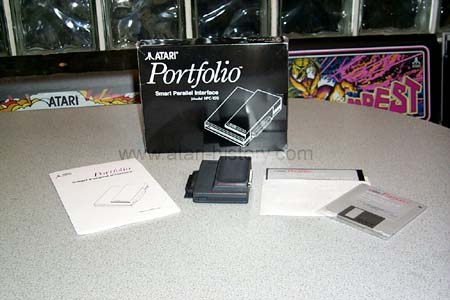

 In 1989 Atari entered into the consumer palmtop market with an innovative
product call The Portfolio. The product was designed by an
England based company that Atari bought. Through the
efforts of a very loyal and determined Atari employee named Don Thomas,
the Atari Portfolio handheld computer was brought to market with a heavy
push on advertising which included a full
page ad in the Wall Street Journal. This remarkable little
computer was actually an IBM XT about the size of VHS video cassette at
about 3/4's the height. It had a PC Card expansion slot (Not
PCMCIA compatible, that spec didn't exist formally for a few more years)
that allowed various card based programs to be loaded or could accept memory
cards for running larger programs or accessing larger data files.
In 1989 Atari entered into the consumer palmtop market with an innovative
product call The Portfolio. The product was designed by an
England based company that Atari bought. Through the
efforts of a very loyal and determined Atari employee named Don Thomas,
the Atari Portfolio handheld computer was brought to market with a heavy
push on advertising which included a full
page ad in the Wall Street Journal. This remarkable little
computer was actually an IBM XT about the size of VHS video cassette at
about 3/4's the height. It had a PC Card expansion slot (Not
PCMCIA compatible, that spec didn't exist formally for a few more years)
that allowed various card based programs to be loaded or could accept memory
cards for running larger programs or accessing larger data files.
 It came packaged with MS-DOS 2.2 compatibility, Lotus 1-2-3 compatible
spreadsheet, a simple text processor, phone book with auto-dialing through
a built-in speaker, calendar and todo list. The Portfolio had a strong
following with several companies introducing software cards, hard drives
and floppy drives for it. One of the more powerful and useful
peripherals for the Atari Portfolio was a device from Atari called the
HPC301 Card Drive for IBM compatible computers to allow a user the ability
to write to an Atari Portfolio Memory Card and then remove it from the
Card Drive connected to a PC and then slide the card into the Portfolio
and the system could read the Card as a disk drive letter and access all
the data. This made for loading updates and syncronizing data
very easy and convenient and gave the user a quick clean system to transport,
store and backup data on the go to and from his/her PC and Portfolio.
Several other devices were also introduced like the Smart Serial and Smart
Parallel interfaces which not only allowed the Portfolio user the ability
to print to Parallel and Serial printers as well as use Modems, the Smart
software also allowed data transfer to and from a PC and the Atari Portfolio
making the users choice of connectivity options varied to his/her own preference.
It came packaged with MS-DOS 2.2 compatibility, Lotus 1-2-3 compatible
spreadsheet, a simple text processor, phone book with auto-dialing through
a built-in speaker, calendar and todo list. The Portfolio had a strong
following with several companies introducing software cards, hard drives
and floppy drives for it. One of the more powerful and useful
peripherals for the Atari Portfolio was a device from Atari called the
HPC301 Card Drive for IBM compatible computers to allow a user the ability
to write to an Atari Portfolio Memory Card and then remove it from the
Card Drive connected to a PC and then slide the card into the Portfolio
and the system could read the Card as a disk drive letter and access all
the data. This made for loading updates and syncronizing data
very easy and convenient and gave the user a quick clean system to transport,
store and backup data on the go to and from his/her PC and Portfolio.
Several other devices were also introduced like the Smart Serial and Smart
Parallel interfaces which not only allowed the Portfolio user the ability
to print to Parallel and Serial printers as well as use Modems, the Smart
software also allowed data transfer to and from a PC and the Atari Portfolio
making the users choice of connectivity options varied to his/her own preference.
